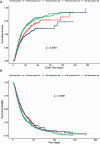Hemoglobin glycation index and neutrophil percentage as predictors of congestive heart failure among individuals diagnosed with sepsis: A MIMIC-IV cohort study
- PMID: 40715448
- PMCID: PMC12297168
- DOI: 10.1038/s41598-025-12453-1
Hemoglobin glycation index and neutrophil percentage as predictors of congestive heart failure among individuals diagnosed with sepsis: A MIMIC-IV cohort study
Abstract
This study aimed to investigate the link between a combined indicator-hemoglobin glycation index (HGI) coupled with neutrophil percentage-and the risk of congestive heart failure (CHF) among patients suffering from sepsis. Adult individuals (aged 18 or older) diagnosed with sepsis and undergoing their initial intensive care unit stay lasting over one day were identified from the Medical Information Mart for Intensive Care IV (MIMIC-IV) database for analysis. The combined indicator-integrating HGI and neutrophil percentage-was grouped into quartiles, labeled Q1 to Q4. The cumulative incidence curves were employed to evaluate the association between this combined indicator and the risk of developing CHF. We carried out Kaplan-Meier (KM) analysis, constructed multivariable Cox regression models, and conducted restricted cubic spline (RCS) analysis for elucidating the association between HGI/neutrophil percentage/the combined indicator and the risk of in-hospital mortality, examining the potential association between HGI/the combined indicator and the risk of CHF, and determining the link between HGI and CHF risk, respectively. 11,089 patients were included, with a CHF incidence of 30.43% in the sepsis cohort. Cumulative incidence analysis indicated that patients with higher levels of the combined indicator exhibited a notably elevated risk of CHF versus those with lower levels (P < 0.0001). KM survival curves demonstrated that elevated levels of the combined indicator or HGI were linked to an elevated in-hospital mortality risk (P < 0.0001). Relative to patients in the combined indicator-Q1, those in Q2, Q3, and Q4 demonstrated an increased risk of CHF, as determined by Cox proportional hazards regression analysis. Higher HGI levels remained significantly linked to elevated CHF risk, as confirmed by multivariable Cox regression analysis. According to the multivariable Cox regression forest plot, patients classified in Q3 of the combined indicator was associated with a higher risk of developing CHF, whereas lower risk was observed among individuals aged ≤ 65 and those who were married. RCS analysis suggested that although the relationship between HGI (ranging from - 3 to 3) and CHF was not strictly linear, higher HGI was associated with an elevated risk of CHF (HR > 1). In critically ill patients with sepsis, the combined indicator (comprising HGI and neutrophil percentage) is an independent risk factor for CHF, showing a significant association with elevated CHF risk.
Keywords: Congestive heart failure; Hemoglobin glycation index; Neutrophil; Sepsis.
© 2025. The Author(s).
Conflict of interest statement
Declarations. Competing interests: The authors declare no competing interests. Conflict of interest: The authors declare that the research was conducted in the absence of any commercial or financial relationships that could be construed as a potential conflict of interest.
Figures





Similar articles
-
Impact of hemoglobin glycation index on prognosis in critical patients with acute ischemic stroke: A retrospective cohort study using MIMIC-IV 2.2 database.Sci Rep. 2025 Jul 2;15(1):23095. doi: 10.1038/s41598-025-07833-6. Sci Rep. 2025. PMID: 40595190 Free PMC article.
-
Association between hemoglobin glycation index and mortality in critically ill patients: a retrospective cohort study.J Health Popul Nutr. 2025 Jul 12;44(1):249. doi: 10.1186/s41043-025-01008-9. J Health Popul Nutr. 2025. PMID: 40652238 Free PMC article.
-
Age-related variation in hemoglobin glycation index and stroke mortality: mediation and machine learning in a cohort study.Sci Rep. 2025 Aug 2;15(1):28206. doi: 10.1038/s41598-025-14028-6. Sci Rep. 2025. PMID: 40753295 Free PMC article.
-
[Volume and health outcomes: evidence from systematic reviews and from evaluation of Italian hospital data].Epidemiol Prev. 2013 Mar-Jun;37(2-3 Suppl 2):1-100. Epidemiol Prev. 2013. PMID: 23851286 Italian.
-
Automated monitoring compared to standard care for the early detection of sepsis in critically ill patients.Cochrane Database Syst Rev. 2018 Jun 25;6(6):CD012404. doi: 10.1002/14651858.CD012404.pub2. Cochrane Database Syst Rev. 2018. PMID: 29938790 Free PMC article.
References
-
- Imonen, R. E. Radiation therapy of giant follicular lymphoma. J. Am. Osteopath. Assoc.72, 1173–1175 (1973). - PubMed
MeSH terms
Substances
LinkOut - more resources
Full Text Sources
Medical

